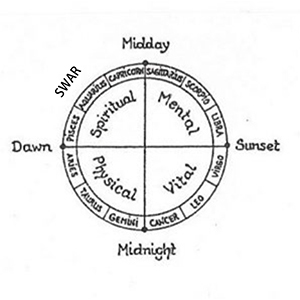The Evolutionary Avatar in the Cosmic Harmony and in Contemporary Vedic Culture
by Thea THE VISHAAL NEWSLETTER, Volume 8 Number 1, April 1993
Indian sacred architecture of whatever
date, style or dedication goes back to some-
thing timelessly ancient and now outside
India almost wholly lost, something which
belongs to the past, and yet it goes forward
too . . . to something which will return upon
us and is already beginning to return, some-
thing which belongs to the future.
Sri Aurobindo
The Foundations of Indian Culture
I have written that what is especially inspiring in the Vedic Way is the consistency of the Knowledge, or the manner in which certain essential elements have been spread throughout the fabric of the civilization which for many millennia has been housed in the Indian subcontinent in an unbroken line. I have used the Capricorn hieroglyph, superimposed on the subcontinental landmass as a focal point, or as a means to demonstrate this consistency. Indeed, the hieroglyph is especially revealing for this purpose, insofar as the Knowledge I refer to centres on this tenth sign of the zodiac.
This is carried over to many aspects of life, many cultural expressions. In modern India it is seen to be relevant given the fact that Makar, the Sanskrit name for the sign, is the most auspicious period of the year. It is the time when pilgrimages are made throughout the breadth of the land, to numerous particularly sacred places established as far back as in the Puranic age and even earlier. The national highways are flooded with pilgrims making their way on foot to these sacred sites in this auspicious Capricorn month.
Indian astrologers made a special effort to determine the correct beginning of this segment in the 12-month year. Of very special importance in connection with this timing was the exact Solstice measurement. A perusal of the old texts does indeed reveal that the establishment of the solstice axis – Capricorn/Cancer – was one of the main concerns of astrologers of old. And we also note that at a certain point in the passage of the Ages it was precisely this measurement, so central a part of the cultural life of the civilisation, which was ‘lost’, as I have pointed out on many occasions in these pages.
But in what way was it ‘lost’? And how could such an easily verifiable measurement have been missed or overlooked when so much emphasis had been placed on its correctness from time immemorial?
Given this factor of central importance, with a number of festivals needing to be located within this time-frame with exactitude, it is clear that the loss of accuracy was itself central to the unfolding destiny of the civilisation. It was not a lapse of one astronomer, or one school imposing its views, or a mistake of some sort which somehow crept into the calculations and then went on compounding itself to the present-day when we realise that the solstice axis is something like 23 degrees off the mark. And furthermore, that it will go on compounding and before long there will be no correlation with the Capricorn/Cancer axis at all, or the shortest and longest day of the year.
At the same time, I have shown in this series the overwhelming importance of Capricorn in the cultural fabric of the civilisation to the point where the hieroglyph even delineates the specific landmass wherein this sign would fulfil itself, at it were, where that Swar, or Heaven, would ‘descend’ upon Earth. The landmass exists and verifies the accuracy of the hieroglyph’s design and the astounding proficiency of the Seer who gave the civilisation this particular symbol. But we find that similar to the time demarcation, or the accurate location of the beginning of this very sign/month in the Earth’s yearly trajectory around the Sun, there has been a ‘loss’ regarding the geographical measurement relating to the same symbol. We note that India looks to her future of independence from foreign subjugation with this loss figuring not only in the time dimension but in space as well. Indeed, as we all know after Einstein’s contribution to physics, the two are interconnected and cannot be separated. Similarly, I contend that the loss of the exact position in time of the Capricorn solstice point resulted in the same disfigurement in space when at the birth of the new India that sacred landmass delineated by the hieroglyph was torn asunder, and at crucial places in the design.
The important point to note is that, as stated, there is a consistency even in the loss. And that it too serves to confirm the immense importance of all things Capricorn in Vedic civilisation from time immemorial. For, while dismembering of the symbol occurred in contemporary history, the dislocation of the time-axis occurred in the early part of the first millennium of our era.
Exactly when this dislocation was first rooted in the cultural fabric is not so easily pin-pointed. But we do have a clear indication of the approximate time in the work of the noted astrologer/mathematician, Varahamihira, and his famous treatise, Brihat Samhita, compiled around 500 AD.
Perusal of this text is a fascinating exercise, especially for students of the New Way. Indeed, the Brihat Samhita appears in many ways to be a precursor of The New Way. The latter is a synthesis of a number of disciplines; and it is the fact of this synthesis which places it out of bounds for academicians. Yet, the Brihat Samhita is a similar synthesis. Moreover, it reveals that this holistic approach was common to the ancient way. The fact that this new Way is incomprehensible or unappreciated by scholars, especially those of the spiritual path today, is logically revealing of just how far removed we are from a poise of consciousness enjoyed by the ancient Seers but lacking even in representatives of contemporary society who are supposed to be descended from those early Rishis.
In fact the problem does indeed lie in the spiritual domain. For it was in that dimension of the ancient civilisationa where the ‘loss’ was first registered. Varahamihira simply carried over into the astronomy of the day that spiritual transgression.
But I must clarify that in those days this designation did not exist. That is, spiritual in contrast or in opposition to material; just as astrology was not divorced from astronomy. In fact, it is this split that engendered the loss of the divine Measure and specifically related to the sign Capricorn. And this severance occurred in the domain of yogic realisation. The time frame was the last 500 years of the millennium before Christ – or the period initiated by the appearance of Gautam, the Buddha. As I have pointed out in the course of my work, the crux of the problem lay in a dissolution (nirvana) of the element which had been serving the human being in his quest, or in the realisation of the inherent purpose of evolution on Earth. As indicated earlier, birth on Earth and into the cosmic process was understood to be an aberration which had to be corrected. This could be done by rejection of the material world of the senses which were responsible for the accumulation of karma and served to chain the human being to the round of birth and death and rebirth. The trick was to sever the chain somehow, to snap one’s ties with this material existence which seemed to be a trap for the seeker of ‘liberation’. The sense-world was a deceptive web which at all costs had to be dissolved. And that was in part accomplished by a process of undermining. The web itself was undermined by decreasing its importance gradually, and finally equating it with the fallen sister of the Divine Maya of the Veda – the temptress and lesser Maya whose name then became synonymous with Illusion.
The web was thus a filament which had no intrinsic reality or real substance, truth-essence. It was simply a tissue of lies fabricated by our imperfect sensorial instrument. Its numerous flaws resulted in a world of suffering and samskaras. This could be dissolved, and along with it the suffering and grief which characterised the lesser world of Maya, by simply undoing the central hub or axis of that unreal web. This axis is known as Skambha in the Atharvaveda. The point of this ‘pillar’ which connects the subtle dimension (Swar) to the physical is known in the spiritual lexicon as the individual soul.

